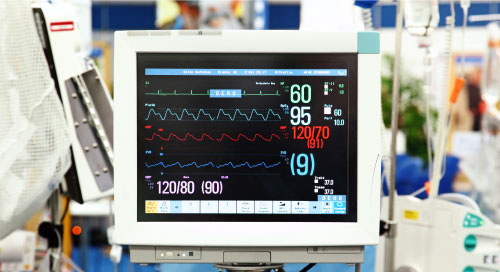Fill form to unlock content
Error - something went wrong!
Your content is just a step away. Please submit below.
Thank you!
Medical Panel PCs Fulfill Hospitals’ Rigorous Requirements

From MRIs and CT scanners to electrocardiograms, oximeters, and blood pressure monitors, today’s medical machines collect an enormous amount of data about patient health. But getting that information into the hands of hospital doctors and nurses who need it is often a struggle.
One problem is that medical machines and devices are made by a wide range of manufacturers. As a result, the information they produce is scattered in incompatible formats across multiple data bases and IT systems, making it hard for doctors and nurses to assemble a coherent picture of patient health.
Another issue is hospitals’ restrictive hardware requirements. Nursing stations, operating rooms, and intensive care units—as well as the labs and pharmacies they connect with—must use computers that meet rigorous hygienic standards. And to successfully transmit vital patient data, the computers must also be very fast, reliable, easy to use, and secure.
Modern medical Panel PCs are designed to meet these challenges. They support data integration from a diverse range of medical equipment via an all-in-one, compact computer that meets hospital sanitary, usability, security, and reliability requirements. And they have the computing power to run the sophisticated medical software that provides caregivers the data they need not only to respond to emergencies but to consistently measure patient progress.
Unifying Patient Monitoring Solutions
Because healthcare technology continuously advances, most hospitals contain a wide range of medical equipment makes and models.
“Hospitals modernize their technology in phases, so they have a very heterogeneous hardware and software environment. Communication protocols are a big pain point,” says Guenter Deisenhofer, Product Manager at Kontron AG, a manufacturer of IoT equipment.
Machines that don’t intercommunicate erode procedural efficiency and make treatment decisions difficult—a problem Deisenhofer recently experienced firsthand after taking his son to a local hospital. First, an intake worker measured the boy’s heart rate, blood pressure, and oxygen level, recording the information on a slip of paper. His son was later seen by a doctor, who took his vital measurements again, writing them on a different paper before sending him off for X-rays—where the process was repeated yet again.
“At the end of the day, there were probably five pieces of paper. They had not continuously monitored his condition and nobody had an overview of it,” Deisenhofer says.
Fortunately, the situation turned out not to be serious. But with vital information arriving from different devices at different times—whether it’s recorded on paper or encoded in incompatible software programs—doctors can never be sure of what they might miss.
Medical edge computers, such as Kontron’s MediClient Panel PC, close the information gap, using a standard protocol to integrate data from machines, wearables, and patient health records. The Panel PC satisfies hospitals’ strict sanitary regulations and is readily accessible to caregivers, even if they’re wearing gloves. It conveys information from patient monitoring machines through wired or wireless connections to hospital communication hubs, such as nursing stations. High-performance Intel® processors enable the monitoring machines’ software to run near-real time analytics on incoming results, helping doctors and nurses see patterns and spot anomalies that may suggest a diagnosis, or point to the need for specific tests.
“With continuous monitoring data available, doctors aren’t just reacting to an emergency. They can see, for example, if the heart rate is dropping and recovering over time. It helps them make better diagnostic and treatment decisions,” Deisenhofer says.
Monitoring can continue after patients are released from the hospital, with wearable devices seamlessly transmitting their information to the MediClient, where it can be integrated with patients’ previous records.
With hospitals increasingly relying on advanced #medical equipment, machine #manufacturers must be vigilant in keeping them updated, both to enable new #IoT functions and to guard against the latest cyberthreats. @Kontron via @insightdottech
Improving Machine Life Cycle Management with Medical Panel PCs
With hospitals increasingly relying on advanced medical equipment, machine manufacturers must be vigilant in keeping them updated, both to enable new IoT functions and to guard against the latest cyberthreats. Making these changes often involves not only software but firmware and sometimes hardware. That means devices like the MediClient PC must also be updated to continue providing hospitals the machines’ vital data.
As technology innovation accelerates, machines that were built to last 10 or 15 years often require several major updates. “Machine life cycle is getting more and more difficult to manage,” Deisenhofer says.
Kontron works closely with medical equipment manufacturers to keep up with planned changes and is often included in early product planning cycles. Because every hardware change requires extensive testing and recertification, close communication saves time. Manufacturers can get their products recertified in one go, instead of having to do so again after making modifications. Kontron also does third-party software installation and electrical testing of manufacturers’ equipment to help them resolve potential problems before release.
Collaboration with Kontron allows manufacturers to deliver upgrades to hospitals sooner—and hospitals can integrate the new capabilities into their medical systems as soon as they are available.
Bringing New Capabilities to the Edge
Working together, OEMs and Panel PC makers can extend the value of monitoring machines as technology advances. The more data the machines collect, the more system builders can improve their AI software, reducing false alarms and pinpointing problems. “For example, you could use AI to create warning scores for recognizing conditions well in advance of a critical situation,” Deisenhofer says.
And the processing speed of edge Panel PCs will improve, helping caregivers respond to identified health threats sooner.
Benefits like these suggest a bright future for patient monitoring machines and the medical Panel PCs that connect their data to doctors and nurses. As Deisenhofer says, “Our device cannot make decisions. But by bringing all the data together at the edge, it can help doctors make the right decisions.”
Edited by Georganne Benesch, Editorial Director for insight.tech.